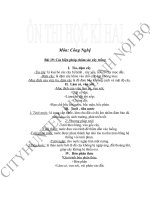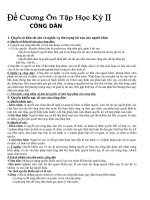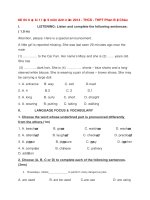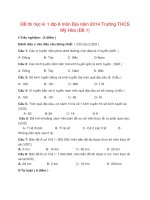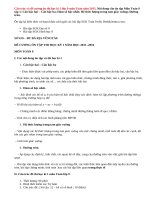Đề cương ôn tập, thi học kì 1 lớp 6 môn Anh năm 2015
Bạn đang xem bản rút gọn của tài liệu. Xem và tải ngay bản đầy đủ của tài liệu tại đây (141.92 KB, 7 trang )
Đề cương ôn tập, thi học kì 1 lớp 6 môn Tiếng Anh năm học 2015 – 2016 mới nhất gồm 8 unit trong
chương trình học kì I.
ĐỀ CƯƠNG ÔN THI HỌC KÌ I – LỚP 6
Năm học 2015– 2016
Môn Tiếng Anh
Unit 1. GREETINGS(Chào hỏi)
1. Greeting people.(Chào hỏi)
•
•
•
•
•
•
•
/ Hi.
Good morning.
Good afternoon.
Good evening.
/ Bye.
Good night.
How are you?
• I’m fine, thank you. And how are you?
• Fine, thanks. And you?
• We’re fine. Thank you. How are you?
2. Introducing oneself and others. (Tự giới thiệu và giới thiệu người khác)
• I’m Lan.
• My name’s Lan.
• This is Trung.
3. Giving one’s age. (Nói tuổi của mình)
• How old are you?
• I’m twelve years old.
• I’m twelve.
4. Counting(Đếm số):
From 1 to 100
Unit 2. AT SCHOOL(Ở trường)
1. Giving commands(Ra lệnh)
•
•
•
•
•
Come in.
Sit down.
Stand up.
Open your book.
Close your book.
2. Giving personal information: name, age, and address. (Cho biếtcác thông tin cá nhân: tên,
tuổi, địa chỉ)
• What’s your name? – My name’s Minh.
• Where do you live? – I live on Le Loi Street.
• How do you spell your name? – L-A-N.
3. Identifying things(Nhận biết đồ vật)
•
•
•
•
What’s this?
What’s that?
This is my school.
That’s my desk.
Unit 3. AT HOME(Ở nhà)
1. Identifying things and family members. (Nhận biết đồ vật và người trong gia đình)
•
•
•
•
•
•
•
•
•
•
This is my bedroom.
That’s our house.
What’s this? – It’s a clock.
What’s that? – It’s a fax machine.
What are these? – They’re chairs.
What are those? – They’re stools.
This is my mother.
That’s my sister.
Who’s this? – It’s my mother.
Who’s that? – It’s my teacher.
2. Talking about quantity.(Hỏi và đáp về số lượng)
• How many students are there? – There are thirty-five.
There is
a / an
danh từ số ít
cụm từ chỉ nơi chốn
There is
a
book
on the table.
There is
an
eraser
in the bag.
There are
từ định lượng
danh từ số nhiều
cụm từ chỉ nơi chốn
There are
two
students
in the class.
There are
five
books
on the table.
How many
danh từ số nhiều
are there
cụm từ chỉ nơi chốn?
How many
books
are there
on the table?
How many
students
are there
in the room?
3. Talking about one’s family. (Hỏi và đáp về gia đình)
•
•
•
•
How many people are there in your family? – There are four.
How old is your mother? – She’s thirty.
What doesshe do? – She’s a teacher.
Where arethey? – They’re at home.
Unit 4. BIG OR SMALL?(Lớn hay nhỏ)
1. Asking and answering questions about locations.(Hỏi và trả lời về nơi chốn và vị trí)
Where + is + place?
It’s + in / on + location.
• Where is your school?
• It’s onNguyen Trai Street.
• It’s inHo Chi Minh City.
• It’s in Ha Noi.
• It’s in Hue.
2. Describing schools and classrooms, using ordinal numbers.(Mô tả trường lớp, sử dụng số thứ
tự)
•
•
•
•
•
•
•
Is your school big? – Yes, it is.
Is it small? – No, it isn’t. It’s big.
Lan’s school is small.
Which grade are you in? – I’m in grade 6.
Which class are you in? – I’m in class 6C.
Where is your classroom? / Which floor is your classroom on? – It’s on the second floor.
How many classrooms does your school have? – It has 20 classrooms.
Ordinal numbers
3. Telling the time.(Nói giờ)
a. Giờ chẵn:
It’s + số giờ + o’clock.
Ex: It’s ten o’clock.
b. Giờ lẻ:
It’s + số giờ + số phút.
Ex: It’s four ten. (4.10)
It’s + số phút + past + số giờ.
Ex: It’s twenty past five. (5.20)
It’s + số phút + to+ số giờ.
Ex: It’s ten to nine. (8.50)
Khi số phút là 15, ta có thể dùng a quarter.
Ex : It’s fifteen past eight. It’s a quarter past eight. (8.15)
Khi số phút là 30, ta có thể dùng half.
Ex : It’s thirty past ten. It’s half past ten. (10.30)
4. Discussing daily routines; asking and telling the time of daily routines. (Hỏi và trả lời về hoạt
động thường ngày; hỏi và trả lời về thời gian các hoạt động hằng ngày)
•
•
•
•
What time is it? / What’s the time? – It’s seven o’clock. / It’s six thirty.
What time doyouget up? – I get up at six o’clock.
What do you do every morning? – I go to school.
What does your father do every day? – He goes to his office.
What time + do / does + S + verb?
S + verb + at + time.
Unit 5. THINGS I DO
1. Asking and answering questions about daily routine. (Hỏi và trả lời về các hoạt động hằng
ngày)
•
•
•
•
•
•
What do you do after school? – I go home and have lunch.
What does he do every day? – He goes to school.
Do you play soccer? – Yes, I do.
Do you play badminton? – No, I don’t. I play soccer.
Does she play volleyball? – Yes, she does.
Does she play soccer? – No, she doesn’t. She plays badminton.
2. Asking and answering questions about the time of daily routine. (Hỏi và trả lời về thời gian
của các hoạt động hằng ngày)
• What time does he get up? – He gets up at six.
• What time does she have lunch? – She has lunch at twelve.
3. Asking and answering about the names of the days of the week, school subjects and the time
related to the school subjects. (Hỏi và trả lời về tên các ngày trong tuần, các môn học và thời
gian liên quan đến các môn học)
•
•
•
•
What do you have today? – We have English and Math.
When does she have English? – She has English on Tuesday.
What time do you have English today? – We have English at 7.30.
Does she have English today? – No, she doesn’t.
Unit 6. PLACES
1. Prepositions of place. (Giới từ chỉ nơi chốn)
• in
•
•
•
•
•
•
•
•
•
•
on
around / round
behind
in front of
opposite
between … and …
near
next to
to the right of
to the left of
2. Describing the sights of a street and around a house. (Mô tả cảnh vật ở một đường phố và xung
quanh nhà)
•
•
•
•
•
•
•
•
My house is on Nguyen Trai Street.
It is next to a supermarket.
There are many stores on the street.
There is a toystore in front of the movie theater.
The police station is behind the bank.
The post office is opposite the drugstore.
The photocopy store is to the right of the theater.
The bank is to the right of the bakery.
3. Questions words. (Từ để hỏi)
•
•
•
•
•
•
•
•
•
Who (ai): hỏi về người (làm chủ ngữ)
Who (ai): hỏi về người (làm tân ngữ)
Whose (của ai): hỏi về sự sở hữu
What (gì, cái gì): hỏi về sự vật, vật hay con vật
Which (nào, cái nào): hỏi về sự lựa chọn
Where (ở đâu): hỏi về nơi chốn
When (khi nào): hỏi về thời gian
Why (tại sao): hỏi về lý do hay nguyên nhân
How(thế nào, cách nào): hỏi về cách thức, trạng thái hay thể cách
4. Asking and answering questions about places where you live. (Hỏi và trả lời về cảnh vật nơi
em sinh sống)
•
•
•
•
Where do you live? – We live in a house in the country.
My house has a yard.
There are trees and flowers in the yard.
What is there near your house? – There is a park near my house.
Unit 7. YOUR HOUSE
1. Asking and answering about the sights around the house. (Hỏi và trả lời về cảnh vật quanh
nhà)
•
•
•
•
Is there a lake in front of your house? – Yes, there is.
Is there a park behind your house? – no, there isn’t.
Are there any trees in the yard? – Yes, there are some trees.
Are there any flowers in the yard? – No, there aren’t.
2. Asking and answering about the neighborhood. (Hỏi và trả lời về khu vực sinh sống)
• Do you live in town? – Yes, I do.
• Does he live in town? – No, he doesn’t.
3. Asking and answering about means of transportation.(Hỏi và trả lời về phương tiện di chuyển)
Ex:
How do you go to school? – I go to school by bike.
How does she travel to work? – She travels by motorbike.
Unit 8. OUT AND ABOUT
1. Asking and answering about activities in process. (Hỏi và trả lời về các hoạt động đang diễn
ra)
• What are you doing? – I’m studying English.
• What is he doing? – He’s practicing English.
• What are they doing? – They’re playing soccer.
2. Asking and answering about activities in process with “Yes-No”questions and “Wh-”
questions. (Dùng câu hỏi “Yes-No” và câu hỏi “Wh-”để hỏi và trả lời về các hoạt động đang
diễn ra)
•
•
•
•
Is she learning English? – Yes, she is.
Are they playing? – No, they aren’t.
Where are you going? – I’m going to the school library.
Who are you waiting for? – We are waiting our classmates.
3. Asking and answering about simple road signs, using “can” and “must”. (Hỏi và trả lời về
một số biển báo giao thông đơn giản, dùng “can” và “must”)
•
•
•
•
You can park here.
You can’t stop here.
You must go straight ahead.
You must not cross the red light.
The end
Xem thêm:
• Đề cương ôn thi, kiểm tra học kì 1 lớp 6 môn Toán năm 2015
• Đề cương ôn tập thi học kì 1 lớp 6 môn Ngữ Văn năm 2015

